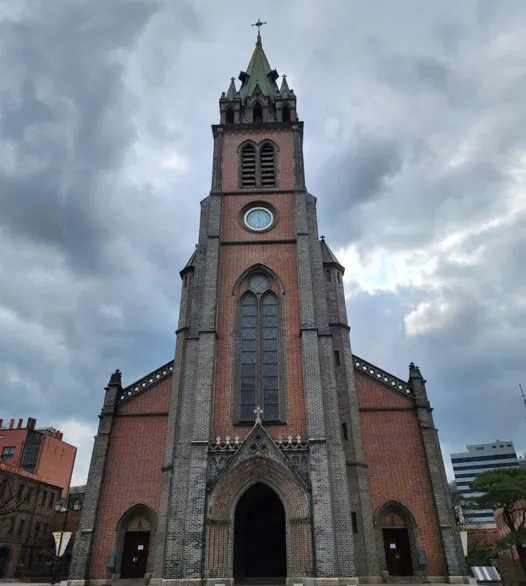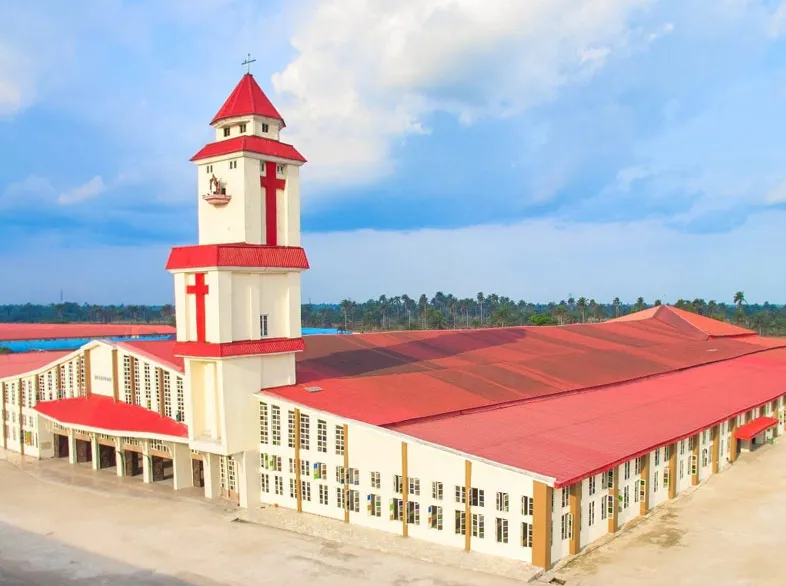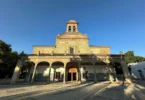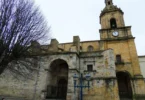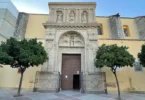The Basilica of the Assumption in Aglona, Latvia is one of the most important Catholic spiritual centers in Latvia. Every year thousands of pilgrims flock to the Basilica on the day of the Assumption of the Blessed Virgin Mary on 15 August. It is one of the eight international shrines recognized by the Holy See and its religious events were attended by around 300,000 pilgrims.
It’s also one of the most important pilgrimage spots in north-eastern Europe. Few people today know that the place of this highly venerated religious site was once extremely important to pagans as a place known for its healing powers. Many centuries ago, Baltic tribes called this area home.
But it was the events of 1236 that really made Aglona both famous and infamous, when King Mindaugas of Lithuania, along with his two sons, were murdered and buried here. In 1688, a prior from Vilnius came to Aglona and built a church and monastery. Firstly, a wooden church arose in 1699, and the following year Dominican fathers constructed a monastery.
The Sanctuary of the Holy House of Loreto, Italy / Our Lady of Loreto & The Holy House of Loreto – Basilica della Santa Casa is a Catholic place of pilgrimage in Loreto, Italy, containing the house in which the Virgin Mary lived.
The Holy House of Our Lady of Loreto is “a rest for the soul”, a place to meet God, and sometimes the inspiring reason and source of strength for new enterprises. A symbolic place of Christianity and home to the Holy House of Nazareth where Mary was born. A destination for pilgrims and art lovers.
It is the third largest shrine to Mary in Europe, next to Lourdes and Fatima. The ministry of the shrine is the hospitality shown to pilgrims especially through the sacrament of penance. The splendid City of Loreto, tucked inside the countryside of the Marches Region, owes its fame to the Sanctuary where the Santa Casa della Vergine Maria (Shrine of the Holy House of the Virgin Mary) is preserved and venerated. It is a holy place defined by Pope John Paul II as “the true Marian heart of Christianity.”
The Pontifical Basilica of Saint Anthony of Padua (Basilica Pontificia di SantAntonio di Padova) is a Roman Catholic church and minor basilica in Padua, Veneto, Northern Italy, dedicated to St. Anthony. Although the Basilica is visited as a place of pilgrimage by people from all over the world, it is not the titular cathedral of the city. a title belonging to the Cathedral-Basilica of St. Mary of Padua. The basilica is known locally as “il Santo”. It is one of the eight international shrines recognized by the Holy See.
The Basilica of Saint Anthony and Padua is one of the largest churches in the. world, visited every year by more than 5 million pilgrims. The relics of Saint Anthony are here preserved.
The Pontifical Basilica. of Saint Anthony. which the people of Padua call II Santo (The Saint), is the most important monument in the city and one of the world’s most important art treasures. Recognised by the Holy See as an International Shrine, it is also one of Christendom’s most celebrated and popular churches. The name of the architect is not known; he may have been a Franciscan friar, a man of genius and of extensive figurative knowledge. The Basilica was initiated in 1232, and its principal part was completed towards the end of that century. It was dedicated to Saint Anthony of Padua. who was born around 1195 in Lisbon, Portugal, and who died in Padua on june 13, 1231.
The Basilica of Our Lady of the Rosary of Fatima. Portugal is a Roman Catholic church and minor basilica in the Sanctuary of Fatima (Marian Shrine of Our Lady of Fatima) in Cova da Iria, in the civil parish of Fatima, in the municipality of Ourém in Portugal.
sanctuary of Our Lady of Fatima is the biggest pilgrimage site in Portugal. Located in Central Portugal, the sanctuary of Our Lady of Fatima has become, throughout the years, the fourth biggest catholic pilgrimage site in the world, due to the apparitions of Virgin Mary to three little shepherds in 1917.
In the Sanctuary of Our Lady of Fatima you can also visit the Basilica of Our Lady of the Rosary of Fatima. Built between 1928 and 1953 in a neo-baroque style, the basilica of Our Lady, of the Rosary has the tombs of Jacinta and Francisco (1951 and 1952). After the death of Licia in 2005, her body was also put to rest in this basilica, side by side with her cousins.
Knock – Ireland’s International Eucharistic and Marian Shrine. Since the Apparition on the 21st of August 1879, pilgrims and visitors have been welcomed to Knock Shrine. We offer a peaceful, contemplative space in which to pray and reflect. Here at Knock. we pray with you and for you.
The Story of Knock
On a wet dark August evening in 1879, the villagers of this place were in their small thatched cottages gathered around their turf fires from which they took warmth and light on such a terrible night. They had spent day doing the usual work of the harvest time of the year – gathering hay, bringing turf home from the bog. Suddenly word spread that something extraordinary was happening at the Church and so they hurried to the windswept gable where they witnessed a heavenly vision surrounded in a brilliant white light.
The Vision
The witnesses clearly saw the Blessed Virgin Mary dressed in white robes, her hands and eyes turned towards heaven in prayer. On her head was a gold crown and where the crown fitted the brow, a single golden rose. On her right, bowed respectfully towards her, was St. Joseph. He appeared older, his beard and hair were grey and, like Our Lady, he was barefoot.
Divine Mercy Krakow Shrine / Divine Mercy Sanctuary, Roman Catholic basilica, Kraków, Poland is at the heart of the Divine Mercy shrine in Kraków-Łagiewniki stands the chapel where the miraculous image of Merciful Jesus and the tomb of St. Faustina are to be found.
This small church, consecrated in 1891 and dedicated to St. Joseph, was built within the complex of the convent of the Sisters of Our Lady of Mercy and once served only the Sisters and their wards.
All about the Spreading of Devotion to The Divine Mercy, Miraculous Image, Chaplet of Divine Mercy, Hour of Mercy.
This chapel has since witnessed the prayer of the Apostle of The Divine Mercy and the extraordinary graces (including the revelations of Jesus and the Blessed Mother) received by her in this place. With her death, the message of God’s Mercy, which by the will of Christ she gave to the Church and the world, was deposited in this place.
The Antipolo Cathedral, Philippines is a Roman Catholic cathedral located in Antipolo City, Rizal in the Philippines. It is also the Immaculate Conception Parish and formally known as the National Shrine of Our Lady of Peace and Good Voyage referred by locals as “Simbahan ng Antipolo”.
It enshrines the Marian image of Our Lady of Peace and Good Voyage (Spanish: Nuestra Señora de la Paz y Buen Viaje), and is the seat of the Bishop of Antipolo.
The Antipolo Cathedral, Philippines attracts millions of pilgrims annually, especially during the Pilgrimage Season which commences with the Alay Lakad from the Quiapo Church on April 30 and lasts throughout the month of May.
The first missionaries in Antipolo were the Franciscans, who arrived in the vicinity in 1578. The Jesuits then followed and administered the church from 1591 until May 1768, when the decree expelling the Jesuits from Spanish lands reached Manila.
The Shrine of Our Lady of Sorrows is a church in the Stary Wielislaw, Poland also known as Sanctuary of Our Lady of Sorrows. The history of the church dates to the tenth century, although the current structure dates only to the 15th century. It is one of the eight International shrines of the Roman Catholic Church.
The church in Stary Wielisław near Polanica Zdrój, in whose main altar has been a statue of the Virgin Mary for centuries, was called the Heavenly Shrine by Pope Boniface VIII in 1300.
The church in Stary Wielisław already existed in the 10th century. On the way to Gniezno, St. Wojciech, The year 1300 turned out to be particularly memorable, when Pope Boniface VIII issued a bull in which he called the Wielisław temple the Heavenly Sanctuary and established it as a pilgrimage church. The first church in Stary Wielisław, burnt down in 1428 by the Hussites, was replaced with a brick one. The current one was built in the 15th century and expanded in the 16th and 18th centuries.

The St Thomas Syro Malabar Catholic International Shrine, Malayattoor (or Malayatoor Church) is one of the eight international shrines in the world, situated in Malayattoor Angamaly, Ernakulam district of Kerala, India. The Malayatoor Church draws numerous devotees not only from India but also from around the globe. It holds significance due to its association with the evangelization efforts of St. Thomas the Apostle in Kerala. Recognized by the Vatican as one of the eight International shrines worldwide, the church is believed to mark the site where St. Thomas offered prayers upon his arrival in Kerala. Positioned atop a hill, the church is situated 15 km away from Kalady town. Malayatoor and Kodanad villages lie on opposite banks of the Periyar river, offering pristine and picturesque views of the surrounding landscape.
The Sanctuary of Our Lady of Lourdes, France (French: Sanctuaire de Notre-Dame de Lourdes) or the Domain (as it is most commonly known) is an area of ground surrounding the Catholic shrine (Grotto) to Our Lady of Lourdes in the town of Lourdes, France. The Sanctuary is a destination for pilgrimage; sick pilgrims are reputed to be miraculously healed by Lourdes water.
This ground is owned and administered by the Roman Catholic Church, and has several functions, including devotional activities, offices, and accommodation for sick pilgrims and their helpers. The Domain includes the Grotto itself, the nearby taps which dispense the Lourdes water, and the offices of the Lourdes Medical Bureau, as well as several churches and basilicas. It comprises an area of 51 hectares, and includes 22 separate places of worship. There are six official languages of the Sanctuary: French, English, Italian, Spanish, Dutch and German.
Grottos intended as replicas of the one at Our Lady of Lourdes, and other grottos in honour of Our Lady of Lourdes, are often described as “Lourdes grottos”.
